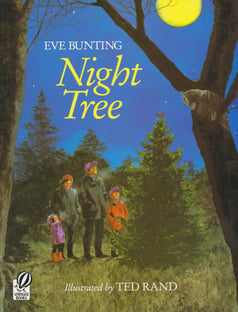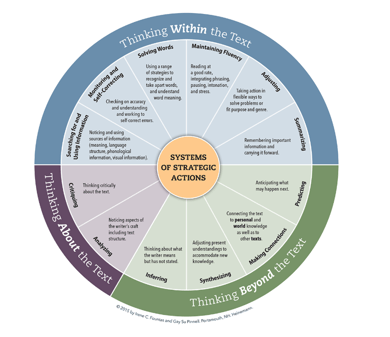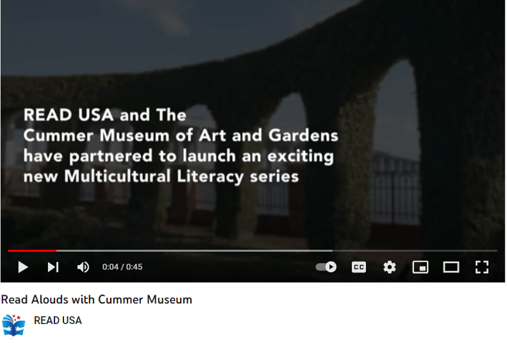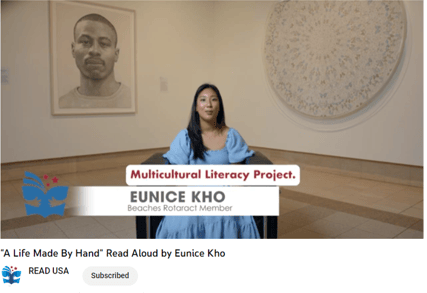This Week at READ USA
Available Now: New Read Aloud Series at the Cummer Museum of Art & Gardens
- Read USA Inc.
- December 21 2022
Last week we asked you, “What do books, art, servant leadership, and diversity have in common?” Well, the answer is an amazing partnership between READ USA, the Cummer Museum of Art & Gardens, and the Rotaract Club of Jacksonville's Beaches that we are announcing today!
Our three organizations have come together to create a unique new series of Read Alouds, where adults read diverse children’s books on video for children to listen, learn, and follow along at their own pace.
The 10-video series, accessible via our YouTube channel, provides children with a variety of stories that reflect different cultures and ethnicities. The purpose behind the series is to help children develop an appreciation of self by being able to experience diverse books featuring people that look like them, while also experiencing the unique artistic and cultural resources available at the Cummer Museum. Ten members of the Beaches Rotaract conducted the Read Alouds at the Cummer Museum and discussed how each of the stories are related to the artworks and gardens featured in the videos.
“The arts and gardens at the Cummer Museum provide visitors with access to beauty and culture as well as a variety of stories from around the world, found in each artwork and landscape,” said Kim Kuta Dring, Director of Learning & Engagement at the Cummer Museum of Art & Gardens. “Pairing artworks and gardens with diverse stories that are read aloud by community volunteers is a powerful way to engage children and families in ‘reading’ artworks. It is our hope that this series of videos will encourage families to visit the Museum to closely explore and talk about art and to explore the stories that surround them every day – in their homes, neighborhoods, schools, and other places they frequent.”
The Beaches Rotaract members who participated in the Multicultural Literacy series and the stories they read aloud include:
- Dr. Danielle Callegari, Former Beaches Rotaract Community Service Chair, reading “Shape Me a Rhyme” by Jane Yolen
- Tatty Chavez, Beaches Rotaract Membership Chair, reading “Harlem Grown: How One Big Idea Transformed a Neighborhood” by Tony Hillery
- Alex Elias, President of Beaches Rotaract, reading “Jayden’s Impossible Garden” by Mélina Mangal
- Nicole Hamm, Beaches Rotaract Immediate Past President, reading “Green Green: A Community Gardening Story” by Marie and Baldev Lamba
- Thomas Hatcher, Former Beaches Rotaract Sergeant-at-Arms, reading “When You Are Away” by Dominique James, Ed.D.
- Sarah Hollingsworth, Beaches Rotaract Member, reading “The Leaf Detective: How Margaret Lowman Uncovered Secrets in the Rainforest” by Heather Lang
- Eunice Kho, Beaches Rotaract Member, reading “A Life Made by Hand” by Andrea D’Aquino
- Sophie Laettner, Beaches Rotaract Member, reading “Summer Birds” by Margarita Engle
- Amy Lehnhoff, Beaches Rotaract Treasurer, reading “More Than A Princess” by Delanda and Terrence Coleman
- Adam Vergales, Beaches Rotaract Member, reading “The Word Collector” by Peter H. Reynolds
Click here to watch this unique new Read Aloud series and for past Read Alouds on our website.
We Need Teen Tutors: Watch READ USA on News4Jax
Yesterday, our CEO Dr. Rob Kelly and one of our amazing teen tutors, Liano, were on News4Jax’s Morning Show to talk with Melanie Lawson about READ USA’s Literacy Tutoring program, tutors’ experience in the program, and our urgent need to hire more than 50 teen tutors to reach our goal of 220 tutors for the coming Spring semester.
Watch the segment here:
We are so thankful to Melanie and News4Jax for welcoming us on The Morning Show, and our special gratitude goes to Liano (and his mom!) for taking the time to join us and share his experience.
Do you know of any teens looking for work this spring? Have them apply NOW!
Training for the Spring semester starts next week, so please encourage interested teens to apply TODAY at www.readusainc.com/apply.
Here are the details:
- Teen tutors use pre-written lesson plans to deliver high-quality reading lessons to help elementary students improve their literacy skills, and READ USA provides supports and resources to our Teen Tutors, including lesson plan training and access to supervising teachers during all tutoring sessions
- Tutors are needed in Mandarin, Southside, Arlington, Town Center and at the Beaches
- Tutors can expect:
- $15/hour
- 9-12 hours a week (Tuesday-Thursday, after school)
- Transportation (if needed) from their high school to the elementary school for tutoring, and from the elementary school to their home
- Tutoring starts January 4 and goes through April
- Onboarding and training dates: 27, 28 and 29 (training and onboarding required and tutors are paid for the training session)
Read more about our Literacy Tutoring program here.
Children’s Book: Night Tree, by Eve Bunting

Illustrated by Ted Rand
Surely to become a Christmas classic, this story captures the quiet, serene tradition of one family at Christmas time. Walking through a dimly lit forest, our host family brings gifts to adorn the tree for the animals. They leave surprises to include tangerines, sunflower seed balls, and popcorn strings. Giving another look at the true meaning of giving at Christmas, the narrative teaches us that every creature is important and deserves our care. When you reflect on your traditions this year, which of those can be attributed to the giving spirit that lifts the most vulnerable among us?
Submitted by Tabetha Cox, Tutoring Program Director
Education Corner - The Five Pillars of Reading: Reading Comprehension
“Comprehension is not about answering those literal questions at the end of a story, chapter, or textbook selection. Comprehension is not about spitting out facts and filling in blanks. Comprehension is about understanding. Reading is thinking.”
-Stephanie Harvey
This week we will be looking at part of the Comprehension component of reading and ways to help students grow in this area.
- Phonological awareness – awareness of the sound structure of words
- Phonics – correlating sounds with letters or groups of letters
- Fluency – accuracy, rate and expression while reading
- Vocabulary – the body of words a child has learned
- Reading comprehension – the understanding and interpretation of what is read
Comprehension can be compared to an intricately woven tapestry. Skills and strategies required for comprehension are connected to each other, creating a masterpiece of thinking about text. We will spend several weeks looking at comprehension due to the depth and breadth of this strategy.
Comprehension is part of a System of Strategic Actions that readers develop over time with instruction and practice. Fountas and Pinnell (2017) developed this illustration to depict the plethora of skills and strategies a reader simultaneously uses as they work to read and comprehend text. The first section of the diagram we will look at is “Thinking Within the Text.” Students need to notice and use the information that is directly stated in the text. While a student is reading, many processes are taking place. They are searching for and using information by thinking about what the text means, if the language sounds right, how the words sound and how they look. The reader is monitoring and self-correcting by thinking about their understanding and correcting errors they notice when they realize it is not making sense. Readers are not only solving words using a range of strategies to recognize and take apart words, and understanding word meaning, but they are also reading at a good rate, integrating phrasing, pausing, intonation and stress in the appropriate places. Whether the student reads fluently, or not, is a window into their comprehension. A students’ comprehension becomes quite obvious when they read a text aloud. Do they read with emphasis in the right place? Do they read the punctuation to emphasize meaning? Does their voice and inflection reflect understanding of the text? Readers also adjust their reading by acting in flexible ways to solve problems or to adapt to the structure of a specific genre. Kids need to know how different types of books work! They need to think about how they read informational text, for example a biography, different than they might read a narrative text. Additionally, while reading within a text, a reader needs to be able to remember important information and carry it forward as they build understanding of the plot.
The notion that a reader implements each of these behaviors simultaneously and rapidly, is monumental. Each of the behaviors mentioned above is dependent upon and a contributing factor to comprehension. The reader who is not comprehending will not be able to successfully apply the strategies and without the mentioned skills will not be able to comprehend well.
Readers need to use all the sources in the text to notice when they don’t understand and work to solve the problem. Most importantly, a reader needs to understand whether a text is making sense or not. Skilled comprehension is knowing when a text doesn’t make sense and knowing how to search for clues to clarify meaning.
So here are some ways to build comprehension skills in the Thinking Within the Text area:
- As the child is reading ask them to pause part way through to think about what they have read. Ask them if they understood the meaning of all the words and if they didn’t, what did they do to fix it? Did they reread or use clues around the word in the sentence to figure out the meaning? Remind them that they may not understand an important part of the text if they don’t understand the meaning of all the words so they should check their understanding frequently. They certainly don’t want to get to the end of the page and have no clue what they read.
- Ask the student if there were tricky words they couldn’t figure out. Ask them to chunk the word into parts or see if there’s a part of the word that they recognize? Ask them to think about what word would make sense there then check to see if the letters match what they are thinking. Then they should reread the sentence to make sure it fits with what is happening in the text.
- The absolute best way to help students with fluency is to be a good model for them. Reading aloud every day with your reader shows them what fluent reading looks like and sounds like. For more explicit instruction, point out the punctuation in a few sentences. Ask the reader to listen to your voice as it goes down to signal a period at the end of the sentence. Tell them to notice how your voice goes up for a question mark, like you would ask a question in conversation. Show them how you pause and take a little breath at commas. Excitedly emphasize the exclamation points at the end of sentences and use the voices when reading aloud!
- Help your student summarize by telling them to make a movie in their mind as they are reading with the idea that they are going to tell a friend what is happening in their reading. Not every detail, but the characters, the main events, the problem and solution, the setting and perhaps the moral or message of the story. A simple way to practice this skill is thinking about S.W.B.S. or Somebody Wanted But So. For example, to retell the story of the Gingerbread Boy you would say. An old man and woman wanted a son, so they made a gingerbread boy to keep them company. But, when the old woman checked to see how he was baking, the gingerbread boy jumped out of the oven and ran away. All of these animals chased him because they wanted to eat him but the fox finally tricked him and gobbled him up. So the old woman and the little old man did not have a son, none of the other animals had gingerbread and the fox was happy.

You can read more about this topic here: https://www.readingrockets.org/helping/target/comprehension




